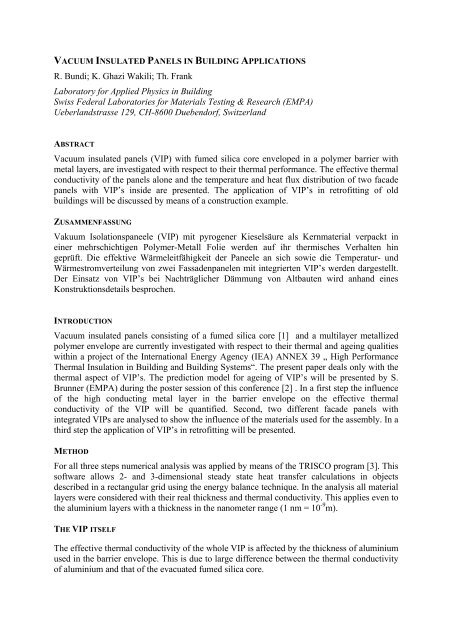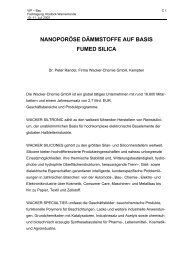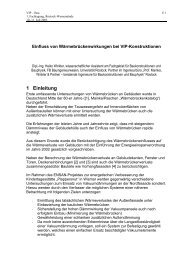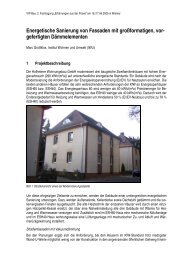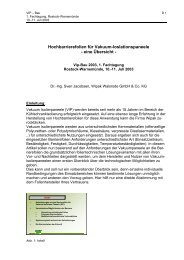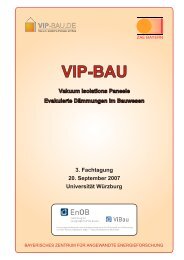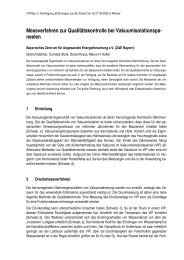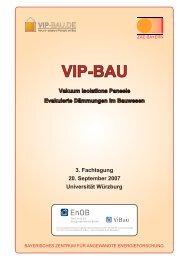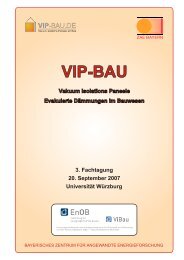Vacuum Insulated Panels in Building Applications - VIP-Bau
Vacuum Insulated Panels in Building Applications - VIP-Bau
Vacuum Insulated Panels in Building Applications - VIP-Bau
You also want an ePaper? Increase the reach of your titles
YUMPU automatically turns print PDFs into web optimized ePapers that Google loves.
VACUUM INSULATED PANELS IN BUILDING APPLICATIONS<br />
R. Bundi; K. Ghazi Wakili; Th. Frank<br />
Laboratory for Applied Physics <strong>in</strong> Build<strong>in</strong>g<br />
Swiss Federal Laboratories for Materials Test<strong>in</strong>g & Research (EMPA)<br />
Ueberlandstrasse 129, CH-8600 Duebendorf, Switzerland<br />
ABSTRACT<br />
<strong>Vacuum</strong> <strong>in</strong>sulated panels (<strong>VIP</strong>) with fumed silica core enveloped <strong>in</strong> a polymer barrier with<br />
metal layers, are <strong>in</strong>vestigated with respect to their thermal performance. The effective thermal<br />
conductivity of the panels alone and the temperature and heat flux distribution of two facade<br />
panels with <strong>VIP</strong>’s <strong>in</strong>side are presented. The application of <strong>VIP</strong>’s <strong>in</strong> retrofitt<strong>in</strong>g of old<br />
build<strong>in</strong>gs will be discussed by means of a construction example.<br />
ZUSAMMENFASSUNG<br />
Vakuum Isolationspaneele (<strong>VIP</strong>) mit pyrogener Kieselsäure als Kernmaterial verpackt <strong>in</strong><br />
e<strong>in</strong>er mehrschichtigen Polymer-Metall Folie werden auf ihr thermisches Verhalten h<strong>in</strong><br />
geprüft. Die effektive Wärmeleitfähigkeit der Paneele an sich sowie die Temperatur- und<br />
Wärmestromverteilung von zwei Fassadenpanelen mit <strong>in</strong>tegrierten <strong>VIP</strong>’s werden dargestellt.<br />
Der E<strong>in</strong>satz von <strong>VIP</strong>’s bei Nachträglicher Dämmung von Altbauten wird anhand e<strong>in</strong>es<br />
Konstruktionsdetails besprochen.<br />
INTRODUCTION<br />
<strong>Vacuum</strong> <strong>in</strong>sulated panels consist<strong>in</strong>g of a fumed silica core [1] and a multilayer metallized<br />
polymer envelope are currently <strong>in</strong>vestigated with respect to their thermal and age<strong>in</strong>g qualities<br />
with<strong>in</strong> a project of the International Energy Agency (IEA) ANNEX 39 „ High Performance<br />
Thermal Insulation <strong>in</strong> Build<strong>in</strong>g and Build<strong>in</strong>g Systems“. The present paper deals only with the<br />
thermal aspect of <strong>VIP</strong>’s. The prediction model for age<strong>in</strong>g of <strong>VIP</strong>’s will be presented by S.<br />
Brunner (EMPA) dur<strong>in</strong>g the poster session of this conference [2] . In a first step the <strong>in</strong>fluence<br />
of the high conduct<strong>in</strong>g metal layer <strong>in</strong> the barrier envelope on the effective thermal<br />
conductivity of the <strong>VIP</strong> will be quantified. Second, two different facade panels with<br />
<strong>in</strong>tegrated <strong>VIP</strong>s are analysed to show the <strong>in</strong>fluence of the materials used for the assembly. In a<br />
third step the application of <strong>VIP</strong>’s <strong>in</strong> retrofitt<strong>in</strong>g will be presented.<br />
METHOD<br />
For all three steps numerical analysis was applied by means of the TRISCO program [3]. This<br />
software allows 2- and 3-dimensional steady state heat transfer calculations <strong>in</strong> objects<br />
described <strong>in</strong> a rectangular grid us<strong>in</strong>g the energy balance technique. In the analysis all material<br />
layers were considered with their real thickness and thermal conductivity. This applies even to<br />
the alum<strong>in</strong>ium layers with a thickness <strong>in</strong> the nanometer range (1 nm = 10 -9 m).<br />
THE <strong>VIP</strong> ITSELF<br />
The effective thermal conductivity of the whole <strong>VIP</strong> is affected by the thickness of alum<strong>in</strong>ium<br />
used <strong>in</strong> the barrier envelope. This is due to large difference between the thermal conductivity<br />
of alum<strong>in</strong>ium and that of the evacuated fumed silica core.
In the European market, there are several producers of <strong>VIP</strong>’s us<strong>in</strong>g different types of barrier<br />
envelopes. In all products alum<strong>in</strong>ium layers are used as barrier material. The thickness of<br />
these layers vary from 8 microns (lam<strong>in</strong>ated alum<strong>in</strong>ium foil) down to 90 nm <strong>in</strong> case of<br />
multilayer metalized foils. For our study we chose <strong>VIP</strong>s from 3 different suppliers with 90,<br />
300 and 8000 nm alum<strong>in</strong>ium respectively.<br />
Cold side<br />
0 °C<br />
Core (fumed silica)<br />
∆ ϑ = 1 °C<br />
20 mm<br />
air<br />
20 °C<br />
Hot side<br />
barrier envelope<br />
Figure 1 : Modelled half of a cross-section through a jo<strong>in</strong>t of two adjacent <strong>VIP</strong>s. Left isothermal, right<br />
material representation<br />
Figure 1 shows the modelled half of a cross-section through a jo<strong>in</strong>t of two adjacent <strong>VIP</strong>s.<br />
Because of wr<strong>in</strong>kles on the envelope and the uneven edge of the panels themselves, there are<br />
always air cavities <strong>in</strong> a <strong>VIP</strong> jo<strong>in</strong>t, which have to be considered <strong>in</strong> the calculations.<br />
Due to the fact that the alum<strong>in</strong>ium layer surrounds the core completely, there is an additional<br />
heat loss through the edge of a <strong>VIP</strong>. This can be represented by a l<strong>in</strong>ear thermal transmittance<br />
(ψ ) . The effective thermal conductivity of the whole <strong>VIP</strong> depends strongly on ψ and the<br />
perimeter to area ratio. This means that small and narrow panel dimensions should be<br />
avoided. A summary of the measured results for a quadratic panel size of 1m x 1m is given <strong>in</strong><br />
Table 1. Theses measurements are made <strong>in</strong> a guarded hot plate device with additional rubber<br />
layer to avoid thermal short circuit<strong>in</strong>g <strong>in</strong> meter<strong>in</strong>g area caused by the envelope.<br />
<strong>VIP</strong><br />
d<br />
[m]<br />
λ cop<br />
[W/mK]<br />
ψ<br />
[W/mK]<br />
λ eff<br />
[W/mK]<br />
Type A 90 nm Aluimium 0.020 4.14 µ 10 -3 6.96 µ 10 -3 4.70 µ 10 -3<br />
Type B 300 nm Aluimium 0.020 3.91 µ 10 -3 9.19 µ 10 -3 4.65 µ 10 -3<br />
Type C 8000 nm Aluimium 0.018 3.95 µ 10 -3 52.44 µ 10 -3 7.73 µ 10 -3<br />
Table 1 Effective thermal conductivity of <strong>VIP</strong>‘s for a quadratic size of 1m µ 1m
These measured results were used to validate our numerical model described above. The<br />
comparison of measurement and calculations shows a good correspondence. Detailed<br />
<strong>in</strong>formation to this topic can be found <strong>in</strong> [4] and [5].<br />
<strong>VIP</strong> USED IN FACADE PANELS<br />
Facade panel is a good example for <strong>VIP</strong> applications <strong>in</strong> build<strong>in</strong>gs. The barrier envelope of a<br />
<strong>VIP</strong> is easily damaged, i.e. the vacuum gets lost, and the <strong>VIP</strong> looses its super <strong>in</strong>sulat<strong>in</strong>g<br />
characteristic. Therefore, it is advisable to deliver the <strong>VIP</strong> <strong>in</strong> a protect<strong>in</strong>g component. This<br />
usually does not need additional effort because facade panels are assembled <strong>in</strong> the workshop<br />
before gett<strong>in</strong>g to the build<strong>in</strong>g site anyhow.<br />
The need for th<strong>in</strong> panels with a good thermal resistance is grow<strong>in</strong>g especially for facade<br />
construction where the transparent and non transparent elements have to be of the same<br />
thickness.<br />
In the follow<strong>in</strong>g two types of facade panels are shown. Their U-Value (thermal transmittance<br />
coefficient) was calculated with both, a 3D and a weighted 1D calculation. The latter neglects<br />
the heat fluxes perpendicular to the heat gradient.<br />
Local thermal bridges are frequent <strong>in</strong> facade construction (screws, local metal sheets, etc.).<br />
Their <strong>in</strong>fluence is larger the better their surround<strong>in</strong>g is thermally <strong>in</strong>sulated. This is the case<br />
when <strong>VIP</strong>s are used.<br />
If a plane element with a high thermal conductivity is connected to such a thermal bridge, it<br />
acts as a heat collector and enforces the heat losses through it. This collector characteristic can<br />
only be calculated <strong>in</strong> 2D or 3D calculations. For the follow<strong>in</strong>g panels, the cladd<strong>in</strong>g sheet acts<br />
as a collector and the spacer go<strong>in</strong>g around the <strong>VIP</strong> as a thermal bridge.<br />
Panel Type 1 stands for the most common type of facade panels where the <strong>in</strong>sulation material<br />
is sandwiched between two metal sheets and the spacer is approx. 30mm thick.<br />
Type 2 is a simplified model for a special panel construction where a th<strong>in</strong> spacer is<br />
approximated by an alum<strong>in</strong>ium sheet of 1mm.<br />
Cold side<br />
Type 1 Type 2<br />
<strong>VIP</strong><br />
PVC<br />
Alum<strong>in</strong>ium<br />
<strong>VIP</strong><br />
Alum<strong>in</strong>ium<br />
Hot side<br />
Figure 2 : cross-sections through the panel edge. <strong>Panels</strong>ize:1 x 1 m2<br />
Material Alum<strong>in</strong>ium PVC <strong>VIP</strong> core<br />
Thermal conduct. λ [W / mK] 160 0.2 0.005<br />
Table 2 : cross-sections through the panel edge. <strong>Panels</strong>ize:1 x 1 m2
U value<br />
3-dimensional 1-dimensional weighted Difference<br />
[W/m 2 K] [W/m 2 K]<br />
Type 1 1.07 0.64 40 %<br />
Type 2 3.27 0.26 92 %<br />
Table 3 U-Values of the two types of panels<br />
Temperature<br />
Heat fluxes<br />
Type 2<br />
Type 1<br />
Figure 3 Temperature- an heat flux distribution. Shown is a 3 dimensional cross section
<strong>VIP</strong> USED IN RETROFITTING<br />
Install<strong>in</strong>g additional heat <strong>in</strong>sulation <strong>in</strong> build<strong>in</strong>gs has <strong>in</strong> the most cases the disadvantage of a<br />
great loss of floor space. Therefore, <strong>VIP</strong>s are of <strong>in</strong>terest for retrofitt<strong>in</strong>g. An additional<br />
thickness of a few centimetres allows to reach good <strong>in</strong>sulation values. The follow<strong>in</strong>g example<br />
shows a retrofitt<strong>in</strong>g of an un<strong>in</strong>sulated build<strong>in</strong>g, where an exterior <strong>in</strong>sulation was impossible<br />
because of the monument conservation laws.<br />
Retrofitted<br />
2.8 m<br />
Orig<strong>in</strong>al<br />
4.1 4.2 4.3 4.4<br />
Figure 4<br />
4.1 Vertical cross-section trough the wall.<br />
4.2 Isothermal view of the cross-section <strong>in</strong> the orig<strong>in</strong>al condition<br />
4.3 Isothermal view of the cross-section <strong>in</strong> the retrofitted condition.<br />
The used <strong>VIP</strong> format is 0.6 x 1.34 m 2 (2 per height between floors)<br />
4.4 Isothermal view of the cross-section <strong>in</strong> the retrofitted condition.<br />
The used <strong>VIP</strong> format is 0.6 x 0.67 m 2 (4 per height between floors)
Total heat fluxes<br />
[W] (∆ T = 20 K)<br />
Orig<strong>in</strong>al construction (4.2) 161.00<br />
Retrofitted construction (4.2) 11.40<br />
Retrofitted construction (4.3) 11.64<br />
Retrofitted construction neglect<strong>in</strong>g<br />
alum<strong>in</strong>ium <strong>in</strong> <strong>VIP</strong>-Envelope<br />
10.81<br />
Table 4 Total energy losses through detail shown <strong>in</strong> Figure 4<br />
The values <strong>in</strong> table 4 show the huge potential of <strong>VIP</strong> <strong>in</strong> this sector of civil eng<strong>in</strong>eer<strong>in</strong>g.<br />
Details as the jo<strong>in</strong>t of the <strong>VIP</strong>s and the connection to the surround<strong>in</strong>g components need to be<br />
solved separately and carefully. On these sites low surface temperatures and air leakages can<br />
cause condensation damages.<br />
ACKNOWLEDGMENTS<br />
The present work got f<strong>in</strong>ancial support from the Swiss Federal Office of Energy.<br />
REFERENCES<br />
1. Caps, R., He<strong>in</strong>emann, U., Ehrmanntraut, M., Fricke, J. : Evacuated <strong>in</strong>sulation panels filled<br />
with pyrogenic silica powders: properties and applications. High Temperatures-High<br />
pressures, 33, 151-156, 2001.<br />
2. Brunner S., et al: Development of service life prediction models for vacuum <strong>in</strong>sulation<br />
panels (<strong>VIP</strong>) (Poster session 6, New construction materials and systems)<br />
3. TRISCO & KOBRU86: Computer program to calculate 3D & 2D steady-state heat<br />
transfer <strong>in</strong> objects described <strong>in</strong> a rectangular grid us<strong>in</strong>g the energy balance technique.<br />
4. Ghazi Wakili, K., Bundi, R., B<strong>in</strong>der, B. : Effective thermal conductivity of vacuum<br />
<strong>in</strong>sulation panels <strong>VIP</strong> used <strong>in</strong> build<strong>in</strong>g constructions, paper submitted to Build<strong>in</strong>g<br />
Research and Information (2003).<br />
5. Simmler, H. : Measurements of physical properties of <strong>VIP</strong>. High Performance Insulation<br />
Systems, <strong>Vacuum</strong> <strong>Insulated</strong> Products (<strong>VIP</strong>), Proceed<strong>in</strong>gs of the <strong>in</strong>ternational conference<br />
and workshop, Ed. Zimmermann, M. and Bertsch<strong>in</strong>ger, H., Centre for Energy and<br />
Susta<strong>in</strong>ability <strong>in</strong> Build<strong>in</strong>gs, EMPA Duebnendorf, Switzerland, 2001.


